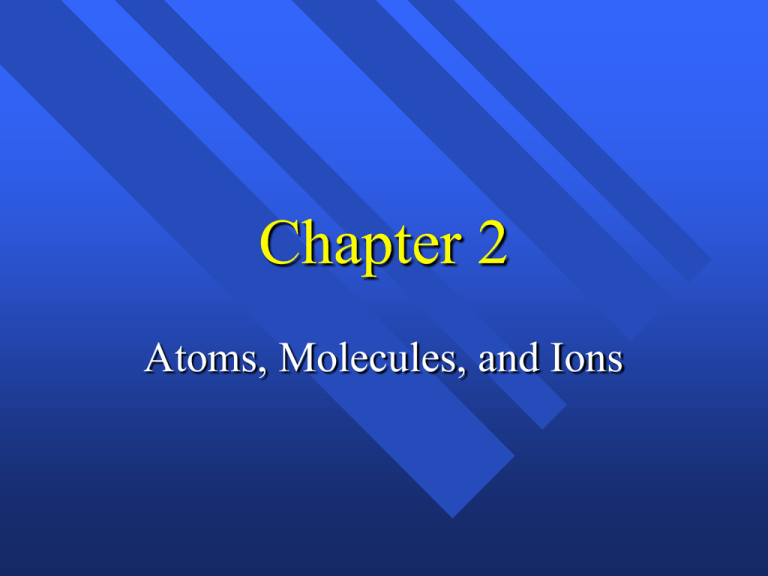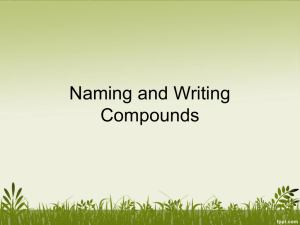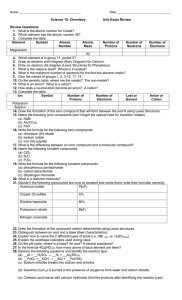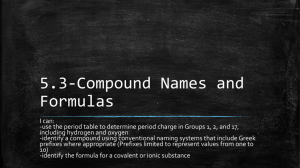Chapter 2 Atoms, Molecules, and Ions
advertisement

Chapter 2 Atoms, Molecules, and Ions Greeks History Democritus and Leucippus - atomos Aristotle- elements. Alchemy 1660 - Robert Boyle- experimental definition of element. Lavoisier- Father of modern chemistry. He wrote the book. Laws Conservation of Mass Law of Definite Proportion- compounds have a constant composition. The react in specific ratios by mass. Multiple Proportions- When two elements form more than one compound, the ratios of the masses of the second element that combine with one gram of the first can be reduced to small whole numbers. What?! Water has 8 g of oxygen per g of hydrogen. Hydrogen peroxide has 16 g of oxygen per g of hydrogen. 16/8 = 2/1 Small whole number ratios. Proof Mercury has two oxides. One is 96.2 % mercury by mass, the other is 92.6 % mercury by mass. Show that these compounds follow the law of multiple proportion. Speculate on the formula of the two oxides. Dalton’s Atomic Theory 1) Elements are made up of atoms 2) Atoms of each element are identical. Atoms of different elements are different. 3) Compounds are formed when atoms combine. Each compound has a specific number and kinds of atom. 4) Chemical reactions are rearrangement of atoms. Atoms are not created or destroyed. A Helpful Observation Gay-Lussac- under the same conditions of temperature and pressure, compounds always react in whole number ratios by volume. Avagadro- interpreted that to mean at the same temperature and pressure, equal volumes of gas contain the same number of particles. (called Avagadro’s Hypothesis) Experiments to determine what an atom was J. J. Thomson- used Cathode ray tubes Thomson’s Experiment Voltage source - + Thomson’s Experiment Voltage source - + Thomson’s Experiment Voltage source Passing + an electric current makes a beam appear to move from the negative to the positive end. Thomson’s Experiment Voltage source By adding an electric field Thomson’s Experiment Voltage source + By adding an electric field, he found that the moving pieces were negative Thomsom’s Model Found the electron. Couldn’t find positive (for a while). Said the atom was like plum pudding. A bunch of positive stuff, with the electrons able to be removed. Millikan’s Experiment Atomizer Oil droplets + - Oil Telescope Millikan’s Experiment X-rays X-rays give some electrons a charge. Millikan’s Experiment FromSome the mass the drop and the charge on dropsofwould hover the plates, he calculated the mass of an electron Radioactivity Discovered by accident Bequerel Three types –alpha- helium nucleus (+2 charge, large mass) –beta- high speed electron –gamma- high energy light Rutherford’s Experiment Used uranium to produce alpha particles. Aimed alpha particles at gold foil by drilling hole in lead block. Since the mass is evenly distributed in gold atoms alpha particles should go straight through. Used gold foil because it could be made atoms thin. Lead block Uranium Florescent Screen Gold Foil What he expected Because Because, he thought the mass was evenly distributed in the atom. What he got How he explained it Atom is mostly empty Small dense, positive piece at center. Alpha particles are deflected by it if they get close enough. + + Modern View The atom is mostly empty space. Two regions Nucleus- protons and neutrons. Electron cloudregion where you might find an electron. Sub-atomic Particles Z - atomic number = number of protons determines type of atom. A - mass number = number of protons + neutrons. Number of protons = number of electrons if neutral. Symbols A X Z 23 Na 11 Chemical Bonds The forces that hold atoms together. Covalent bonding - sharing electrons. Makes molecules. Chemical formula- the number and type of atoms in a molecule. C2H6 - 2 carbon atoms, 6 hydrogen atoms, Structural formula shows the connections, but not necessarily the shape. H H C H There H C H H are also other model that attempt to show three dimensional shape. Ball and stick. Ions Atoms or groups of atoms with a charge. Cations- positive ions - get by losing electrons(s). Anions- negative ions - get by gaining electron(s). Ionic bonding- held together by the opposite charges. Ionic solids are called salts. Polyatomic Ions Groups of atoms that have a charge. Yes, you have to memorize them. List on page 66 Periodic Table Metals Conductors Lose electrons Malleable and ductile Nonmetals Brittle Gain electrons Covalent bonds Semi-metals or Metalloids Alkali Metals Alkaline Earth Metals Halogens Transition metals Noble Gases Inner Transition Metals +1+2 -3 -2 -1 Naming compounds Two types Ionic - metal and non metal or polyatomics. Covalent- we will just learn the rules for 2 non-metals. Ionic compounds If the cation is monoatomic- Name the metal (cation) just write the name. If the cation is polyatomic- name it. If the anion is monoatomic- name it but change the ending to –ide. If the anion is poly atomic- just name it Practice. Ionic compounds If the cation is monoatomic- Name the metal (cation) just write the name. If the cation is polyatomic- name it If the anion is monoatomic- name it but change the ending to -ide If the anion is poly atomic- just name it practice Ionic Compounds Have to know what ions they form off table, polyatomic, or figure it out CaS K2S AlPO4 K2SO4 FeS CoI3 Ionic Compounds Fe2(C2O4) MgO MnO KMnO4 NH4NO3 Hg2Cl2 Cr2O3 Ionic Compounds KClO4 NaClO3 YBrO2 Cr(ClO)6 Naming Covalent Compounds Two words, with prefixes Prefixes tell you how many. mono, di, tri, tetra, penta, hexa, septa, nona, deca First element whole name with the appropriate prefix, except mono Second element, -ide ending with appropriate prefix Practice Naming Covalent Compounds CO2 CO CCl4 N2O4 XeF6 N4O4 P2O10 Writing Formulas Two sets of rules, ionic and covalent To decide which to use, decide what the first word is. If is a metal or polyatomic use ionic. If it is a non-metal use covalent. Ionic Formulas Charges must add up to zero. Get charges from table, name of metal ion, or memorized from the list. Use parenthesis to indicate multiple polyatomics. Ionic Formulas Sodium nitride sodium- Na is always +1 nitride - ide tells you it comes from the table nitride is N-3 Ionic Formulas Sodium nitride sodium- Na is always +1 Nitride - ide tells you it comes from the table nitride is N-3 Doesn’t add up to zero. +1 Na -3 N Ionic Formulas Sodium nitride sodium- Na is always +1 nitride - ide tells you it comes from the table nitride is N-3 Doesn’t add up to zero Need 3 Na +1 Na -3 N Na3N Ionic Compounds Sodium sulfite calcium iodide Lead (II) oxide Lead (IV) oxide Mercury (I) sulfide Barium chromate Aluminum hydrogen sulfate Cerium (IV) nitrite Covalent compounds The name tells you how to write the formula duh Sulfur dioxide diflourine monoxide nitrogen trichloride diphosphorus pentoxide More Names and formulas Acids that produce H+ ions when dissolved in water. All acids begin with H. Two types of acids: Oxyacids Non-oxyacids Substances Naming acids If the formula has oxygen in it write the name of the anion, but change –ate to -ic acid –ite to -ous acid Watch out for sulfuric and sulfurous H2CrO4 HMnO4 HNO2 Naming acids If the acid doesn’t have oxygen add the prefix hydro change the suffix -ide to -ic acid HCl H2S HCN Formulas for acids Backwards from names. If it has hydro- in the name it has no oxygen Anion ends in -ide No hydro, anion ends in -ate or -ite Write anion and add enough H to balance the charges. Formulas for acids hydrofluoric acid dichromic acid carbonic acid hydrophosphoric acid hypofluorous acid perchloric acid phosphorous acid Hydrates Some salts trap water crystals when they form crystals. These are hydrates. Both the name and the formula needs to indicate how many water molecules are trapped. In the name we add the word hydrate with a prefix that tells us how many water molecules. Hydrates In the formula you put a dot and then write the number of molecules. Calcium chloride dihydrate = CaCl22O Chromium (III) nitrate hexahydrate = Cr(NO3)3 6H2O



